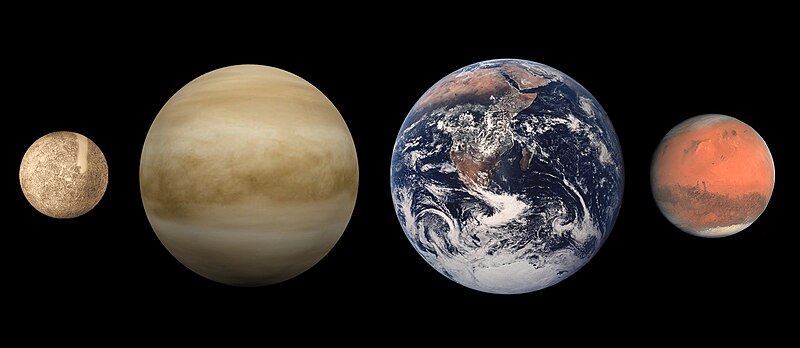Պատկեր:Terrestrial planet size comparisons.jpg

Նախադիտման չափ՝ 800 × 348 պիքսել։ Այլ թույլտվությաններ: 320 × 139 պիքսել | 640 × 279 պիքսել | 1500 × 653 պիքսել.
Սկզբնական նիշք (1500 × 653 փիքսել, նիշքի չափը՝ 314 ԿԲ, MIME-տեսակը՝ image/jpeg)
Նիշքի պատմություն
Մատնահարեք օրվան/ժամին՝ նիշքի այդ պահին տեսքը դիտելու համար։
| Օր/Ժամ | Մանրապատկեր | Օբյեկտի չափը | Մասնակից | Մեկնաբանություն | |
|---|---|---|---|---|---|
| ընթացիկ | 20:39, 4 Դեկտեմբերի 2018 |  | 1500 × 653 (314 ԿԲ) | Allice Hunter | Correcting Mars |
| 17:21, 3 Դեկտեմբերի 2018 |  | 1500 × 653 (315 ԿԲ) | Allice Hunter | updated: correcting the color of Mars. Based on image of Mars >> File:OSIRIS Mars true color.jpg. There was no distortion in size | |
| 22:37, 15 Հուլիսի 2012 |  | 1500 × 653 (276 ԿԲ) | Ubiquinoid | updated: correcting for apparent undersizing of Venus (from 90 to 95% (true) of Earth's diameter) - based on image of Venus w/NASA cloup map (resized) at http://cronodon.com/PlanetTech/Venus.html; centred | |
| 14:52, 15 Հուլիսի 2012 |  | 1500 × 653 (79 ԿԲ) | Ubiquinoid | updated: correcting for apparent undersizing of Venus (95% of Earth's diameter) - based on image of Venus w/cloup map (resized) at http://cronodon.com/PlanetTech/Venus.html | |
| 23:50, 27 Դեկտեմբերի 2007 |  | 1500 × 653 (456 ԿԲ) | Crotalus horridus~commonswiki | Created identical and more compact version using the "Huffman optimized" feature of jpegcrop. Nothing else has been changed. | |
| 23:27, 14 Հունիսի 2006 |  | 1500 × 653 (488 ԿԲ) | Nicke L | {{Information| |Description= The inner planets, from left to right: en:Mercury, en:Venus, en:Earth, and en:Mars Source: http://solarsystem.nasa.gov/multimedia/gallery/terr_sizes.jpg |Source= |Date= |Author=User [[:en:User:Brian0918|Br |
Նիշքի օգտագործում
Այս նիշքին օգտագործող էջեր չկան։
Նիշքի համընդհանուր օգտագործում
Հետևյալ այլ վիքիները օգտագործում են այս նիշքը՝
- Օգտագործումը af.wikipedia.org կայքում
- Օգտագործումը arz.wikipedia.org կայքում
- Օգտագործումը az.wikipedia.org կայքում
- Օգտագործումը bat-smg.wikipedia.org կայքում
- Օգտագործումը ba.wikipedia.org կայքում
- Օգտագործումը be-tarask.wikipedia.org կայքում
- Օգտագործումը beta.wikiversity.org կայքում
- Օգտագործումը be.wikipedia.org կայքում
- Օգտագործումը bxr.wikipedia.org կայքում
- Օգտագործումը ca.wikipedia.org կայքում
- Օգտագործումը cv.wikipedia.org կայքում
- Օգտագործումը da.wikipedia.org կայքում
- Օգտագործումը da.wikisource.org կայքում
- Օգտագործումը de.wikipedia.org կայքում
- Օգտագործումը de.wikisource.org կայքում
- Օգտագործումը de.wikiversity.org կայքում
- Օգտագործումը en.wikipedia.org կայքում
- User:Can't sleep, clown will eat me
- User:Newone
- Wikipedia:Featured picture candidates/Terrestrial planet size comparisons
- Wikipedia:Featured picture candidates/May-2006
- Talk:Dwarf planet/Archive 1
- Wikipedia:Featured picture candidates/February-2007
- Wikipedia:Featured picture candidates/Terrestrial planets
- User:Can't sleep, clown will eat me/User/appetizers
- Wikipedia:Featured picture candidates/August-2007
- Wikipedia:Featured picture candidates/Terrestrial planet size comparisons.jpg
- User:Mitternacht90/EarthandSpace
- User:HarryAlffa/Solar System synopsis
- Talk:Solar System/Archive 5
- User:Physchim62/Planetmass
Տեսնել այս նիշքի ավելի համընդհանուր օգտագործումը:

